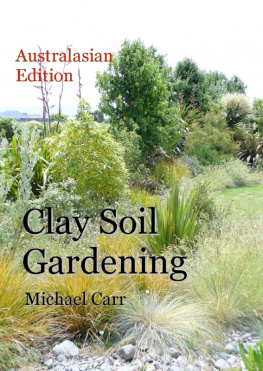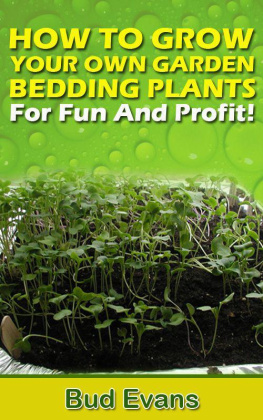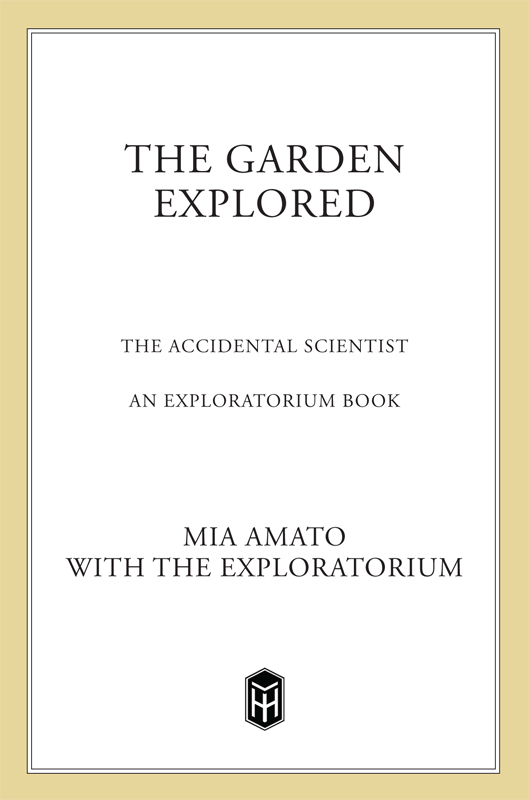
The author and publisher have provided this e-book to you for your personal use only. You may not make this e-book publicly available in any way. Copyright infringement is against the law. If you believe the copy of this e-book you are reading infringes on the authors copyright, please notify the publisher at: us.macmillanusa.com/piracy.
Contents
For Paul
Mia Amato
Introduction
Welcome to the Accidental Scientist, a series of books created by the Exploratorium to help you discover the science thats part of things you do every day.
In The Garden Explored we investigate the science of soil and water, of seeds and seasons, of bugs and roots. We answer questions that will help you no matter where you garden. Why should you always water on a rising temperature? Why do you prune at a certain time of year? Why do plants root more readily if theres a willow branch rooting in the same water?
The Garden Explored is filled with experiments that you can try in your own garden. Create your own hybrids by cross-pollinating irises. Diagnose common garden ailments by examining a plants leaves. Use your knowledge of a plants inner plumbing to shape a tree with selective pruning. Get the most out of your growing season by mapping where shadows fall in your yard.
At the Exploratorium, San Franciscos museum of science, art, and human perception, we believe that learning how things work is not only fascinating and funbut can also expand and enrich your experience of your favorite activities. Knowing that the texture of a plants leaves indicate its water needs can help you choose the right shrubs for your yard. Realizing how plants absorb nutrients from the soil can help you fertilize more wisely. Understanding the wildlife that visits your garden can help you attract birds and butterflies and discourage snails and other pests.
Be warned: weve found that once you start noticing the science in gardening, you may find it difficult to stop. Youll find yourself noticing things that you never paid any attention to before and asking questions that you never thought to ask. Have fun!
Gory Delacte
Director
Exploratorium
Plants and People
Exploring the Natural World

It is a popular fiction that people who write about gardens must have spectacular, gorgeous plantings in their backyards. Not me. My friends actually make jokes about my garden and call it The Lab because there are always so many experiments going on, some in beds, some in pots, some on the windowsill. This usually means that at least one area in the garden looks perfectly horrible, because a test I was running on disease resistance in old-fashioned roses has resulted in blobby, splotchy shrubs, or the peanut crop was thwarted by rummaging squirrels.
Nothing ventured, nothing gainedand the words, You cant grow that here are fighting words to me. True, I live in northern California, which supports a wide variety of landscape choices, but Ive been told again and again my climate is too cold to grow blood oranges, and also that my climate is far too warm to produce flowers on the Ume, the Japanese flowering plum ( Prunus Mume ), which blooms in the snow in Tokyo. Well, my backyard Ume blooms just fine, thank you, and last year I did get three fruits from my Moro blood orange, and they were very tasty indeed.
Nobody sees a flower, reallyit is so smallwe havent time, and to see takes time, like to have a friend takes time.
Georgia OKeeffe
If you are reading this book, I suspect you might also be the kind of gardener with an open mind and an itchy trowel. Perhaps you, too, have grown dissatisfied with the gardening advice that can be gleaned from books, radio call-in shows, and your own Aunt Fannydo this, do that, do it at this certain time. Just dont ask why, because thats the way it is. Well, this book will tell you why certain things work and certain things dont, and will give you a scientific basis for backyard gardening that you can use with every plant you grow.
Gaining knowledge about the natural world allows you to adapt your gardening style, and manipulate soil, water, fertilizers, even animals and insects, to help your garden grow. You dont have to be a rocket scientist to understand the basic theories, and you dont need fancy equipment. Long before we had electron microscopes to dissect plants to the very core of their protoplasts, gardeners puzzled out many botanical theories using only their own five senseswhat scientists today would call empirical observationalong with dirt-plain common sense.
Imagine, for instance, that you were a gardener living in Spain some 500 years ago. A friend drops off some seeds for you, from a plant he does not have a name for. Grow these seeds, says your friend, and youll be surprised at what you geta plant with delicate yellow flowers and the most delicious berries!
Sure you want to grow the seedsbut how, when you dont know what kind of plant it is? It helps when your friend tells you the seeds came from a distant tropical jungle, where the summers were baking hot and there was no winter snow. The climate was unbearably humid, and it rained a lot.
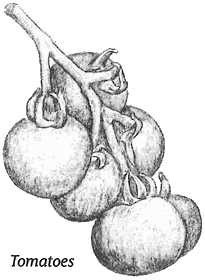
So you might try your luck with a scientific approach, waiting until your winter frosts were over to plant the seeds in the warmest, sunniest spot in your vegetable garden. Youd give the seedlings plenty of water. Perhaps youd notice the plants grew lengthy shoots, but had no tendrils or suckers to cling with, so you might tie the vine up off the ground so the little fruits would not be damaged. And boy are those fruits tasty!
And so you could successfully grow a tomato plant, even if you didnt know tomato was its name. Back in the 1500s, when the golden age of plant exploration began with Columbuss transit between hemispheres, gardeners were just as avid to try something new as we are today. They treasured every scrap of knowledge about new fruits and flowers, and learned by luck, trial, and error.
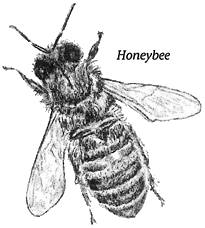
Modern gardeners might do well to imitate those adventurous gardeners of an earlier era, taking the added advantage of all we have learned since 1500. If you want to grow a better tomato in your own garden, it helps to realize the tomatos original home is the tropical jungles of Central America. Suddenly so much of tomato growing makes sense: why they wither in the cold; why surrounding the plants with heat-radiating black plastic mulch or a black rubber tire makes the plants grow faster; why honeybees often ignore their flowers, but bumblebees love them. (The bumblebees that usually pollinate tomatoes are, like the tomato plant, only native to the Western Hemisphere.)
Be More Than a GardenerBe a Plant Explorer
The average suburban backyard contains what in 1500 would have been an astounding collection of plant species gathered from the four corners of the globe. Dahlias in the flower bed come from Mexico, while the yellow forsythia hedge hails from China, and the tulips along the walk are native to Turkey. Rhododendrons flanking the front door originated from the Himalayan snows of Tibet. That African violet on grandmas windowsill comes from African rain forests.



